This conclusion from a general view of human nature, we may confirm by particular instances, wherein the force of sympathy is very remarkable. Most kinds of beauty are derived from this origin; and though our first object be some senseless inanimate piece of matter, it is seldom we rest there, and carry not our view to its influence on sensible and rational creatures. A man, who shews us any house or building, takes particular care among other things to point out the convenience of the apartments, the advantages of their situation, and the little room lost in the stairs, antichambers and passages; and indeed it is evident, the chief part of the beauty consists in these particulars. The observation of convenience gives pleasure, since convenience is a beauty. But after what manner does it give pleasure? It is certain our own interest is not in the least concerned; and as this is a beauty of interest, not of form, so to speak, it must delight us merely by communication, and by our sympathizing with the proprietor of the lodging. We enter into his interest by the force of imagination, and feel the same satisfaction, that the objects naturally occasion in him.
This observation extends to tables, chairs, scritoires, chimneys, coaches, sadles, ploughs, and indeed to every work of art; it being an universal rule, that their beauty is chiefly derived from their utility, and from their fitness for that purpose, to which they are destined. But this is an advantage, that concerns only the owner, nor is there any thing but sympathy, which can interest the spectator.
It is evident, that nothing renders a field more agreeable than its fertility, and that scarce any advantages of ornament or situation will be able to equal this beauty. It is the same case with particular trees and plants, as with the field on which they grow. I know not but a plain, overgrown with furze and broom, may be, in itself, as beautiful as a hill covered with vines or olive-trees; though it will never appear so to one, who is acquainted with the value of each. But this is a beauty merely of imagination, and has no foundation in what appears to the senses. Fertility and value have a plain reference to use; and that to riches, joy, and plenty; in which though we have no hope of partaking, yet we enter into them by the vivacity of the fancy, and share them, in some measure, with the proprietor.
There is no rule in painting more reasonable than that of ballancing the figures, and placing them with the greatest exactness on their proper centers of gravity. A figure, which is not justly ballanced, is disagreeable; and that because it conveys the ideas of its fall, of harm, and of pain: Which ideas are painful, when by sympathy they acquire any degree of force and vivacity.
Add to this, that the principal part of personal beauty is an air of health and vigour, and such a construction of members as promises strength and activity. This idea of beauty cannot be accounted for but by sympathy.




